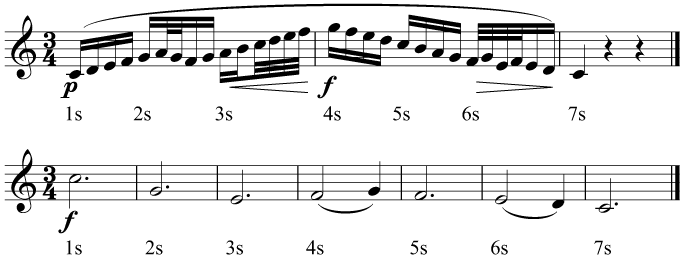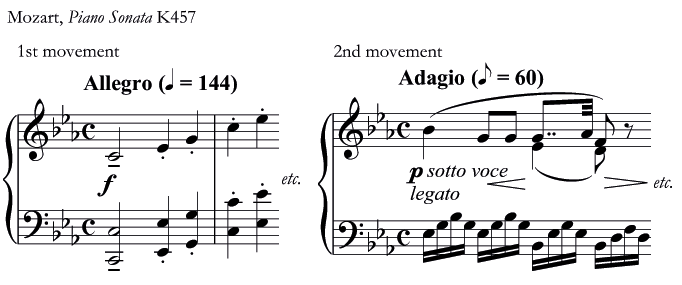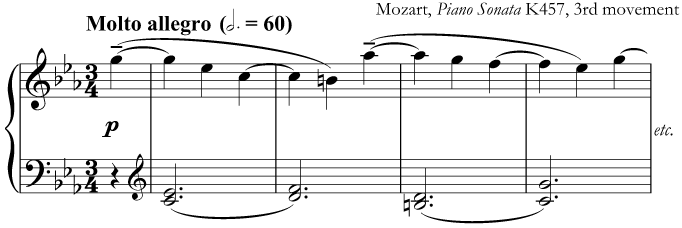Tempo: fast and slow
In this guide...
Key terms:
Subscription required!
To view the complete study guide, you will need a valid subscription. Why not subscribe now?
Already have a subscription? Make sure you login first!
Introduction
You might think that "fast" and "slow" were simple concepts in music. Well, they are; but there are a few important subtleties worth learning about, which we'll look at now.
Fast and slow
What do we mean when we say "this is a fast piece of music"?
Clearly, if there are lots of notes in a given space of time, we might consider that to be fast. Similarly, if there are not a lot of notes, we might think that was slow.
However, things are a little more complicated than that. Look at these two pieces of music, one with lots of semiquavers and the other with just minims. Which is faster?
 Which is the faster piece of music?
Which is the faster piece of music?In fact, both could be fast, or both could be slow; what is important is how many beats there are in a given span of time (say, a minute, or 10 seconds). In the upper example, four semiquavers occur in a beat; in the lower example, each note corresponds to three beats.
It would be possible for the lower example to be much faster than the upper example, by having many more beats in the same span of time. In fact, it might be natural to play these two pieces with a crotchet in the upper example corresponding to three crotchets in the lower example.
In this case, the lower example would be three times as fast! To prove this, imagine if the lower example then introduced semiquavers - they would be much more rapid than those in the upper example.
Tempo
When we talk about the speed of a piece of music, therefore, we have to be careful that we are talking about the frequency of beats and not simply the number of notes.
We use the term tempo to talk about this specific sense of speed: a piece has a faster tempo than another piece if more beats occur in the first piece than occur in the same span of time in the second piece.
This diagram might make matters a little clearer, showing the passing of seconds in the two pieces from our first example.
 The passing of beats and seconds in two pieces of music
The passing of beats and seconds in two pieces of musicYou can see that there are many more beats in the lower example over the same 7 seconds than there are in the upper example, and therefore the lower example has a faster tempo.
Tempo in classical music
Indeed, it is very common in classical music for slow movements to be written in semiquavers and demisemiquavers, and for fast movements to be written using quavers and crotchets!
Compare these two examples, from the same piano sonata by Mozart; the first is from a fast 1st movement:
 Music from a fast movement by Mozart
Music from a fast movement by MozartAnd the second is from a slow 2nd movement:
 Music from a slow movement by Mozart
Music from a slow movement by MozartIn conclusion: don't be fooled by the apparent density of notes on the page!
Tempo terms
There are many words used in music that indicate the tempo, and you can see two of them in the Mozart examples above: Adagio and Allegro. Every piece of music should have a descriptive term like this at the beginning (and anywhere else the tempo changes), and you will need to learn what all these words mean.
It is normal to see Italian words (such as Adagio and Allegro but you might also see similar words in German, French and of course English. Traditionally, however, Italian is used.
A marking such as Adagio, meaning "slow", indicates that the beat should be slow; it does not necessarily mean that there are not many notes passing by every second - quite the contrary; in some Mozart slow movements there are some very rapid passages!
Likewise, a marking such as Allegro, meaning "quick", indicates that the beat should be quick, even though there may not be many notes per beat.
There is a table showing various common terms for tempo at the bottom of this page, and you will need to become familiar with all of these.
Measuring the tempo
There is a more precise way of indicating the tempo than using descriptive Italian words, and that is to give a metronome mark. This is given as a beat duration (such as a crotchet) and a number (such as 120); this means that there would be 120 beats of crotchet length per minute.
This is quite a familiar way of measuring the frequency of events: it is the same technique that doctors use when measuring the speed of your pulse, and you may have heard the expression "beats per minute" or bpm.
The metronome
The metronome is a mechanical or electronic device which accurately beats out a tempo at a selected number of beats per minute. It was invented in 1815 by Johann Maelzel, and in some music from that time you might see a marking such as "M.M. 120", in which the "M.M." stands for "Maelzel's Metronome". Before this date, metronome markings were of course not used, and descriptive words were the only indication of tempo.
Here are the openings of the two Mozart pieces with suitable metronome marks:
 The two Mozart movements with suitable metronome markings
The two Mozart movements with suitable metronome markingsThe danger of metronome markings
It is tempting to rely on the apparent clarity of metronome markings, and they are excellent tools for practice. However, they can potentially lead to performances that are very mechanical and predictable.
Mechanical - because following a metronome very closely means that the tempo cannot change, even slightly, in the course of a piece; but varying the tempo is one of the best expressive tools available to musicians.
Repetitive - because if everyone played a given piece of music at precisely the same tempo, we would never discover the full potential of that piece. "Adagio", by contrast, simply means that the tempo is "slow", and it is up to the performer to musically interpret precisely how slow to play the piece, perhaps discovering a new meaning as a result.
You will sometimes, therefore, see a range of metronome markings, such as "120-132", which allows for some freedom of expression while still being relatively precise.
Subdividing the beat
When playing slow music, it is common to subdivide the beat. If the beat is extremely slow, it can be difficult to count accurately, especially if there are several performers playing together.
Furthermore, if the music is written using semiquavers and demisemiquavers (as in the Mozart above), it can be hard to play the rhythm accurately if the beats are very far apart.
In these cases, it is common to count out the subdivisions of the beat: counting quavers when the beat is normally in crotchets, for example.
Here is the same Mozart piece with some counting written in. We are counting "in 8", eight quavers per bar, one per second, rather than the more usual four crotchets of Common Time:
 Counting in a slow movement by Mozart
Counting in a slow movement by MozartIt is already quite tricky to count out seconds - they are surprisingly slow! - and it's twice as hard to count out crotchet beats that only occur once every two seconds.
Very fast music
Sometimes, in very fast music, you might see a metronome mark which shows how many whole bars occur in a minute, rather than beats!
This is the case in the 3rd movement from the same Mozart piano sonata as in the examples above, as shown here:
 A very fast movement by Mozart
A very fast movement by MozartIn this movement, we count each bar in "one", and to practice we would set our metronome to 60, and play one whole bar to each tick of the metronome. The music looks quite simple on the page - until you come to try and play it at that speed!
Fast or slow? - Revisited
The word Molto in the last example simply means "very", so Molto allegro literally means "very fast".
However, you can see that the metronome marking given is exactly the same as that given in the slow movement - 60 per minute. Yet one is fast and one is slow!
This is accounted for by calculating the number of beats in the bar in each tempo. In the Adagio movement, the time signature is C for Common Time, i.e. four crotchet beats to the bar; that means there are a mere 30 crotchets per minute if there are 60 quavers per minute, as indicated in the metronome mark.
In the Molto allegro movement, which is in 3/4, there are three crotchet beats to the bar, and 60 bars per minute - so there are 180 crotchets per minute!
So you can see: the very fast 3rd movement is six times as fast as the slow 2nd movement! (30 x 6 = 180)
Tempo markings
The following table shows various descriptive terms and the corresponding English meanings, together with approximate metronome markings for each.
| Term | Meaning | Metronome beat |
|---|---|---|
| adagio lento | slow | 40-60 |
| grave | slow, solemn, serious | 40-72 |
| largo | slow, stately, broad | 48-72 |
| larghetto | rather slow, but less slow than largo | 56-80 |
| andante | at a walking pace | 76-108 |
| andantino | slightly faster than andante | 80-112 |
| moderato | moderately | 100-120 |
| allegretto | fairly quick (not as quick as allegro) | 112-132 |
| allegro | quick (literally "cheerful") | 120-144 |
| vivace vivo | lively, quick | 132-160 |
| presto | fast | 144+ |
Modifiers
In addition, there are a few terms that are used in combination with a tempo marking to give additional information:
| Term | Meaning | Example |
|---|---|---|
| poco | a little | poco allegro = a little quickly |
| meno | less | poco meno allegro = a little less quickly |
| molto | very / much | molto allegro = very quickly |
| moderato | moderately | allegro moderator = moderately quickly |
| ma non troppo | but not too much | allegro ma non troppo = quickly, but not too quickly |
| assai | very | allegro assai = very quickly |
Read more...
With a subscription to Clements Theory you'll be able to read this and dozens of other study guides, along with thousands of practice questions and more! Why not subscribe now?
Revision
Are you sure you've understood everything in this study guide? Why not try the following practice questions, just to be sure!